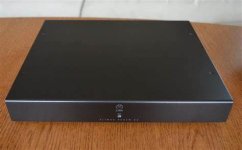Lucky discovery today: I used the Linn with a lower spec Shunyata Venom power cord earlier. Reason being, the Klimax’ aluminum cover overlapping the connectors on the backside does not allow for use of the bulky Oyaide/ Furutech type C16 connectors a lots of high end cables nowadays have.
That cable is good, if you you have a tad bright sounding gear which might benefit from a slight mid/ lower bass boost. However, the Linn DS/3 does not need that. Listening to it in my main system, I felt a bit the opposite. It sounded a bit too phat for my liking.
Browsing better cables with smaller connectors on the interweb, I remembered coming across an older La Rosita cable, when searching for guitar parts in the garage (that’s another story, I’m currently having a British luthier modding a ‘52 re-issue Tele into a Micawber - a thing I have been looking for some time). But back to the power cord.
La Rosita is a small French audio boutique, which started making NOS streamers, when those became a fad about ten years ago. I once had one of their products, and kept the La Rosita aftermarket power cord when I sold the streamer. I found it to be very good for the purpose, offering good dynamics, an even top-to-bottom balance, great clarity across the frequency range and an overall neutral sound. This was long before firms like Shunyata and AQ started to make dedicated source cables.
The only thing with the db system v2 Super PowerCord is, it looks like someone had neutered the family iron. Not sure what the guys were thinking, must be some French thing. The box in the middle is an electrical interference absorber.
With this cable all the Linn Klimax DS/3 benefits come to the fore, as it does not require any pushing in one or the other direction. A very good combination indeed.
The Bach Concertos album by Hilary Hahn sounds really excellent. In fact, it sounded so fantastic I listened to the entire album via the Linn, while having a 30K vinyl rig sitting next to it with a brand new cartridge waiting for burn-in. A bit surprising. OK, I ordered the vinyl as well [emoji3].
Reading up on the La Rosita cable to refresh my memory, I also discovered that it used to be the go-to cable for a number of Linn enthusiasts a couple years back. No wonder it sounded so good. Lucky me, you really never know what you find lurking in your garage.
Sent from my iPad using Tapatalk






